Publications > Article
Strategic approaches to restoring ecosystems can triple conservation gains and halve costs
International commitments for ecosystem restoration add up to one-quarter of the world’s arable land. Fulfilling them would ease global challenges such as climate change and biodiversity decline but could displace food production and impose financial costs on farmers. Here, we present a restoration prioritization approach capable of revealing these synergies and trade-offs, incorporating ecological and economic efficiencies of scale and modelling specific policy options. Using an actual large-scale restoration target of the Atlantic Forest hotspot, we show that our approach can deliver an eightfold increase in cost-effectiveness for biodiversity conservation compared with a baseline of non-systematic restoration. A compromise solution avoids 26% of the biome’s current extinction debt of 2,864 plant and animal species (an increase of 257% compared with the baseline). Moreover, this solution sequesters 1 billion tonnes of CO2-equivalent (a 105% increase) while reducing costs by US$28 billion (a 57% decrease).








